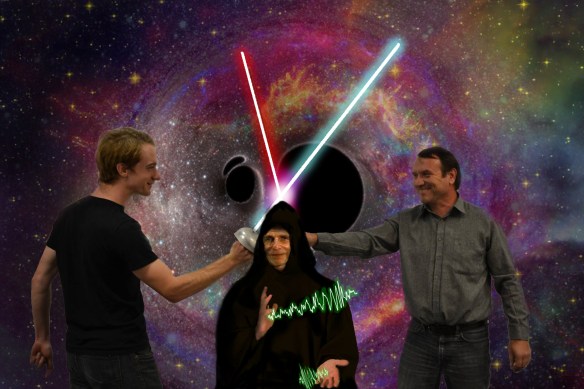Written by Casey Handmer, a postdoctoral scholar at the California Institute of Technology. Bela Szilagyi is a researcher at NASA’s Jet Propulsion Laboratory. Jeffrey Winicour is a professor at the University of Pittsburg. Find out more on their group website at www.black-holes.org.

Casey Handmer (Caltech), Bela Szilagyi (JPL) and Jeffrey Winicour (Pittsburg) reprise their former stance discussing asymptotically time-like inertial scri+ foliations, now with even better CGI. Image credit: Photo manipulation by Annie Handmer, background image by SXS Collaboration: Andy Bohn et al 2015 Class. Quantum Grav. 32 065002.
Gravitational waves were detected in 2015. GW150914 wiggled LIGO’s mirrors and shook the whole world, except perhaps Stockholm. The opening paragraph of our previous CQG+ article was rendered obsolete:
“Colliding black holes create powerful ripples in spacetime. Of this we are certain. Directly detecting these ripples, or gravitational waves, is one of the hardest unsolved problems in physics.”
That article presented the evolution algorithm that simulates gravitational waves from compact object binaries in computational general relativity. The evolution algorithm is the powerful engine that drives the present work: extraction of all radiative energy-momentum flux in addition to the usual strain and gravitational news.
How did this come about? At APS April 2014, my coauthor Bela and I were approached by Jeffrey Winicour: Bela’s doctoral advisor and, we learned, a referee of our first paper. He excitably described how we could use our evolution algorithm to compute the gravitational wave flux. I schemed to co-opt all other possible referees in the same way.
What is the flux? The ten Poincaré symmetries of asymptotically flat spacetime generate respective conserved Noether momenta: linear momentum, angular momentum, energy, and three boost momenta corresponding to Lorentz transforms. Supertranslations, a possible solution to the Firewall Paradox, also generate momenta that are calculated using this method.
Along the way we discovered a number of surprises. Did you know that spherical foliations of future null infinity in inertial coordinates are actually asymptotically time-like? Read more in our CQG paper.
Read the full article in Classical and Quantum Gravity:
Spectral Cauchy characteristic extraction of strain, news and gravitational radiation flux
Casey J Handmer et al 2016 Class. Quantum Grav. 33 225007
Sign up to follow CQG+ by entering your email address in the ‘follow’ box at the foot of this page for instant notification of new entries.
CQG papers are selected for promotion based on the content of the referee reports. The papers you read about on CQG+ have been rated ‘high quality’ by your peers.
This work is licensed under a Creative Commons Attribution 3.0 Unported License.
Tell your friends about CQG+





You must be logged in to post a comment.